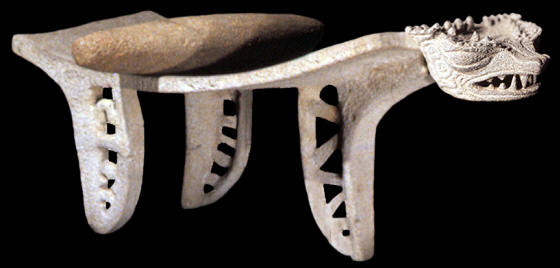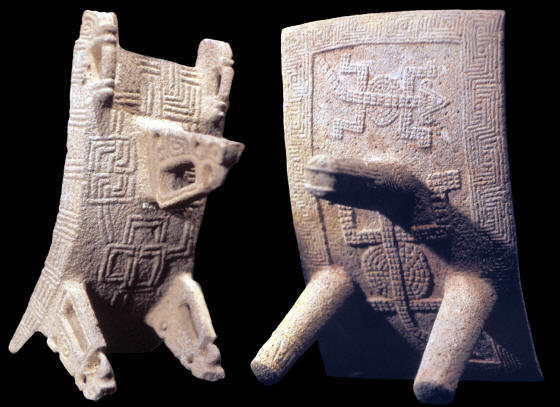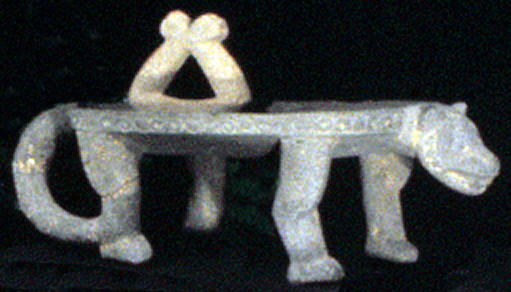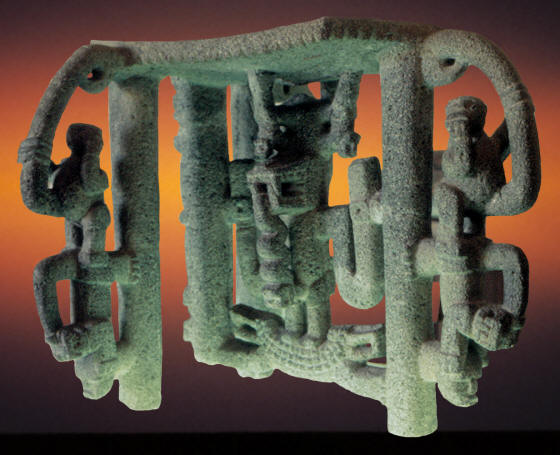|
"In the centuries
(in Costa Rica)
when jade was the most important symbolic material, special, ornately
sculpted metates became the principal sculptural vehicle through which
the deities linked to agriculture were portrayed"----1998,
Michael J. Snarskis, "The Imagery And Symbolism Of Precolumbian Jade In
Costa Rica" Jade In Ancient Costa Rica, p. 62.
"It has been
proposed by Lange that the Nicoya metates found in the elite graves at
Las Huacas (Costa Rica)
and elsewhere functioned as chieftains seats, signifying their status
and power. The idea stems from the custom of Circum-Caribbean groups who
bury chiefs with their stools."--------1988,
Alice C. Tillett, "Sacred Symbols Of Life And Death In Northern
Costa Rica," Costa Rican Art And Archaeology, Essays In Honor Of
Frederick R. Mayer, p. 50.
"The
interrelated religious connotations of corn, the color yellow, and the
chiefly status held by the metate reflects several levels of religious
and political significance in prehistoric Lower Central America."----1988,
Alice C. Tillett, "Sacred Symbols Of Life And Death In Northern
Costa Rica," Costa Rican Art And Archaeology, Essays In Honor Of
Frederick R. Mayer, p. 51.
"---we found a large stone metate (on
the Loma Corral 3 site in northwestern Costa Rica),
placed plate up, with extremely fragile human teeth on top of the plate.
---(it) had been ceremonially killed by the removal of one support that
we never found elsewhere."---------2013,
Michael Snarskis, "Loma Corral 3, Culebra Bay, Costa Rica, An Elite
Burial Ground With Jade And Usulutan Ceramic Offerings,"
Pre-Columbian Art & Archaeology, Essays In Honor Of Fredrick R. Mayer, pp.
65 & 69.
"Burial VIII (at Las Huacas in
northwestern Costa Rica) held the
remains of three persons together with three decorated metates and
various small objects"----1998,
Julie Jones, "Jade In Ancient Costa Rica," p. 16.
"The
richest burials included imported Usulutan pottery, decorated local
pottery, pendants of both true jade and social jade, and tripod metates."----2013,
Michael Snarskis, "Loma Corral 3, Culebra Bay, Costa Rica, An Elite
Burial Ground With Jade And Usulutan Ceramic Offerings,"
Pre-Columbian Art & Archaeology, Essays In Honor Of Fredrick R. Mayer,
p. 81.
"In the cemetery at
Tibas, Snarkis reported a burial extended on metates of the Atlantic
watershed type accompanied by northwestern Costa Rican style jadeite
pendants and carved mace heads, and Guerrero found a similar burial at
La Fabrica de Grecia."----1988, Alice C. Tillett, "Sacred Symbols Of Life And Death In Northern
Costa Rica," Costa Rican Art And Archaeology, Essays In Honor Of
Frederick R. Mayer, p. 50.

CEREMONIAL METATES
NORTHERN COSTA RICA
est. A.D. 300 to 1000
Ceremonial metates are one of the most
recognized stone artifact types in Costa Rica, next to giant stone
spheres, maces and axe-god jade pendants. They are remarkable for
their artistic qualities, diversity of style and fine craftsmanship.
Ceremonial metates were made by full-time craftsmen who produced some of
the best stonework ever made in the Americas. |
|

COMPUTER ALTERED IMAGE FROM LITHIC CASTING LAB'S COLLECTION OF
ORIGINAL IMAGES
CLICK ON PICTURE FOR LARGER IMAGE
CEREMONIAL "SERPENT" METATE WITH
MONO
GUANACASTE PROVINCE
NORTHWESTERN COSTA RICA
This ceremonial metate was found in
northwestern Costa Rica in Guanacaste Province. Its main sculptural
feature is a finely carved serpent head. The other interesting
feature are three support legs that are perforated with triangular
cutouts. This metate measures 14 1/4 inches (36.2 cm) high. The
stone mono laying on its grinding plate is a common form. It measures 25 inches (63.5 cm)
long. |
|
|
Metates were used as kitchen tools for grinding corn.
Only a few were made especially for ritual purposes. Common metates have
thick grinding plates and are supported by three short legs. The more
rare refined forms are referred to as ceremonial metates. They are
taller with three or four legs and have thinner
grinding plates that curve slightly upward on each end. |
|

COMPUTER ALTERED IMAGE FROM LITHIC CASTING LAB'S COLLECTION OF
ORIGINAL IMAGES
CLICK ON PICTURE FOR LARGER IMAGE
CEREMONIAL METATES
NORTHWESTERN COSTA RICA
Both of these ceremonial metates were found on sites in northwestern
Costa Rica. They illustrate the elaborate design patterns that are
carved on the legs and grinding plates of some examples. The flat
legs with cutout designs and round legs with carved lines are
typical design traits. The figures carved on the metate on the right are
described as crocodiles. The metate on the left measures 10 inches
(25.3 cm) high and the metate on the right measures 12 inches (30.5
cm) high. |
|
|
Some ceremonial metates are undecorated. But the more refined
examples are engraved with complex designs on both the legs and the plates.
The most impressive metates are carved with heads and bodies of various
types of birds, reptiles, mammals, and even corn. Some of the metates
from the Atlantic watershed on the eastern side of Costa Rica are
described as having four legs, a raised rim around the grinding plate
and several small heads carved onto the lower edge of the plate. |
|

COMPUTER ALTERED IMAGE FROM LITHIC CASTING LAB'S COLLECTION OF
ORIGINAL IMAGES
CLICK ON PICTURE FOR LARGER IMAGE
CEREMONIAL METATE WITH MONO
NORTHWESTERN COSTA RICA
HIGHLANDS
This picture shows a complex form of a
ceremonial metate. It appears to have some type of animal figures
incorporated into the design. The grinding plate is fairly flat and
serrated along the bottom edge. It measures 8 3/4 inches (22.2 cm)
high. |
|
|
Costa Rican ceremonial metates are found exclusively
in burials. They are often found with rich offerings of carved jades and
maces that indicate high ranking individuals. The "metate and greenstone
ornament combination" is an archaeological burial feature that has been
observed throughout Costa Rica. |
|

IMAGE FROM LITHIC CASTING LAB'S COLLECTION OF
ORIGINAL IMAGES
CEREMONIAL "FELINE" METATE
LINEA VIEJA, COSTA RICA
This ceremonial metate was found in
the northeastern region of Costa Rica where metates with four legs
have been reported. It was sculpted in the natural form of a feline,
possibly a jaguar. The grinding plate is flat, compared to many
other examples. Besides its four legs, it has knee joints, paws and
a tail. It measures 8 1/8 inches (20.3 cm) tall. The pestle measures
5 1/2 inches (14 cm) high. |
|
|
Metates were made from several different types of stone. From
the desert southwest in the U.S. to South America, they were made from
granite, rhyolite, andesite, basalt, quartzite, sandstone, and
limestone. Vesicular (pitted) basalt is and was the best type of stone
to use. This type of volcanic stone is long-lasting and self-sharpening.
As the natural pits in the stone are worn away new ones open up. Many of the ceremonial metates of
Costa Rica are made of basalt. |
|

COMPUTER ALTERED IMAGE FROM LITHIC CASTING LAB'S COLLECTION OF
ORIGINAL IMAGES
EXTREMELY ELABORATE CEREMONIAL METATE
NORTHERN COSTA RICA
This ceremonial metate illustrates one of
the extreme examples of the complex sculptural forms these unique
artifacts were being produced. It stands on three support legs that
have a variety of different types of animal forms that are
incorporated into the design pattern beneath the grinding plate. |
|
|
In mythology, metates are connected to life through their
association with maize (corn). The Olmec recognized the maize god as
their second most important deity and they saw maize as a divine
substance. The Mayans believed that man was fashioned from yellow and
white corn. The color yellow is also associated with the sun's cosmic
energy. Even today, when Mayan women are interviewed about the
importance of metates they will say "the metate is the reason we are
alive" or "if we have no metate, we wouldn't eat (2011
Searcey)." |
|

IMAGE FROM LITHIC CASTING LAB'S COLLECTION OF
ORIGINAL IMAGES
DOMESTIC NAVAJO KITCHEN SCENE
ILLUSTRATING COMMON METATE WITH MONO
MUSEUM DIORAMA
NEW MEXICO
This picture shows a portion of the
interior of a Navajo house in New Mexico. The scene is actually a
diorama museum display. A common and standard variety of metate can
be seen to the left, along with a mono and, what appears to be,
ground corn. These types of simple metates are still in use is some
areas today. |
|
|
The connection between
ceremonial metates and maize is obvious, but it's still not exactly
clear how these specialized grinders were used. They have been found
both face up and face down in graves. Two individuals, in different
cemeteries, are reported to have been laid on top of several metates. In
another grave, jade artifacts were laid on the grinding plate. The
remnants of poorly preserved human teeth were found on another grinding
plate. They have been described as chieftains' seats and as ritual
grinders of food and drugs for special ceremonies. They were probably
used in several different ways. We do know, for sure, that they are very
unique forms of stone sculpture that have a rich archaeological history
from one of the most beautiful countries in
the world. |
|
"REFERENCES"
1984, Snarskis, Michael J., "The
Archaeology Of Lower Central America," Central America:
The Lower Caribbean.
1988, Tillett, Alice C., "Sacred Symbols Of Life And Death In Northern
Costa Rica," Costa Rican Art And Archaeology, Essays In Honor Of
Frederick R. Mayer, p. 50.
1998, Jones, Julie, "Jade In Ancient Costa Rica," p. 16.
1998, Snarskis, Michael J., "The Imagery And Symbolism Of
Pre-Columbian Jade In Costa Rica" Jade In Ancient Costa Rica,
p. 62.
2011, Searcey, Michael T, "The Life-Giving Stone, Ethnoarchaeology
Of Maya Metates," p.138.
2013, Snarskis, Michael, "Loma Corral 3, Culebra Bay, Costa Rica, An Elite
Burial Ground With Jade And Usulutan Ceramic Offerings,"
Pre-Columbian Art & Archaeology, Essays In Honor Of Fredrick R. Mayer, pp.
65 & 69.
|
|
RECENT
LISTINGS HOME
ORDERING |